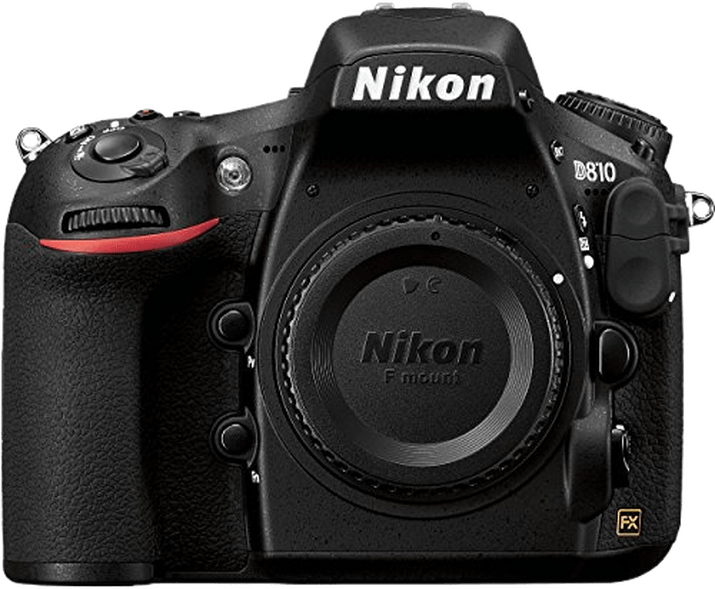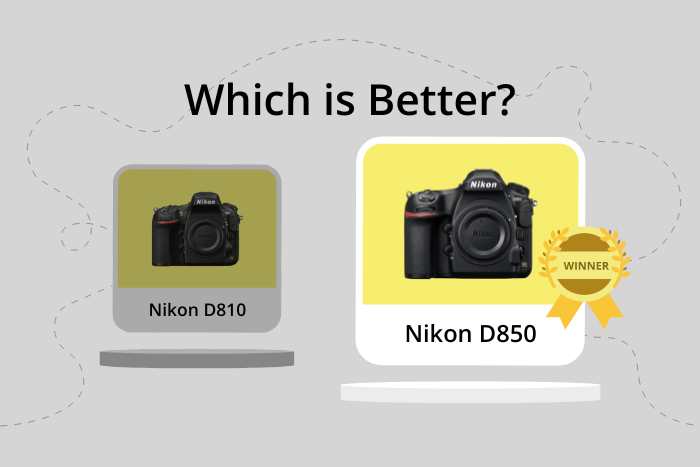Nikon D810 vs D850 Comparison
Nikon D810

Nikon D850

The Nikon D850 emerges as the winner with a score of 82/100, while the Nikon D810 trails behind at 72/100. Both cameras are DSLRs and were launched at a price of $3300. They also have similar dimensions, with the D810 measuring 146 x 123 x 82mm and weighing 980g, and the D850 at 146 x 124 x 79mm and 1005g.
The D850 outperforms the D810 with its higher score, showcasing its superiority in the world of DSLR cameras. However, the D810 has a slight advantage in terms of weight, being 25g lighter than the D850.
Taking these factors into account, the Nikon D850 is a better choice for those seeking top-notch performance and features, while the D810 remains a reliable option for those who prioritize a slightly lighter camera.
Nikon D810 vs D850 Overview and Optics
The Nikon D850 emerges as the winner in optics, scoring 79/100, compared to the Nikon D810’s 76/100. Both cameras share certain specifications, such as the CMOS sensor type, Full Frame sensor size, Nikon F FX lens mount, and absence of image stabilization.
The D850 surpasses the D810 in several aspects. With 45.7 megapixels, the D850 offers higher resolution than the D810, which has 36.3 megapixels, providing more detailed and sharper images. Additionally, the D850’s shooting speed of 7 frames per second (fps) is faster than the D810’s 5 fps, enabling photographers to capture fast-moving subjects better. The D850 also has an advantage in terms of its Expeed 5 processor, which allows for faster image processing and better noise reduction compared to the D810’s Expeed 4 processor. Lastly, the D850’s sensor received a DXOMARK score of 100, indicating better overall image quality than the D810’s score of 97.
On the other hand, the D810 still has merits despite its lower score. Its 36.3-megapixel resolution is still considered high and capable of producing quality images. Furthermore, its 5 fps shooting speed may be sufficient for some photographers’ needs, depending on their subjects and shooting styles.
The Nikon D850 proves to be the superior choice in terms of optics, offering higher resolution, faster shooting speed, and better image quality. However, the Nikon D810 remains a viable option for photographers who may not require the additional features and can make do with its specifications.
Nikon D810 vs D850 Video Performance
The Nikon D810 and Nikon D850 both have a video score of 70/100, indicating that they are equal in terms of video capabilities. They share common features such as time-lapse functionality built in, which is a useful tool for creating stunning time-lapse videos.
The Nikon D850 has a clear advantage in terms of video resolution, as it offers 4K video recording with dimensions of 3840 x 2160. This means that the D850 is capable of capturing videos with higher detail and clarity compared to the D810, which only offers Full HD video recording with dimensions of 1920 x 1080. However, the D810 has a higher maximum video frame rate of 60fps, compared to the D850’s 30fps. This allows the D810 to capture smoother video footage, especially in fast-paced scenarios or when slow motion effects are desired.
In certain situations, the Nikon D810 may be a better choice for video recording due to its higher maximum frame rate. Faster frame rates can be useful for sports or action videography, where capturing rapid movement is critical. However, the D850’s 4K video resolution is a significant advantage for those who prioritize video quality and detail.
Based on these differences, the Nikon D850 is the better choice for videographers who prioritize high-resolution video quality, while the Nikon D810 is more suitable for those who need higher frame rates for specific situations. Both cameras offer excellent video capabilities, and the choice between them depends on individual preferences and requirements.
Nikon D810 vs D850 Features and Benefits
The Nikon D850 emerges as the winner with a feature score of 87/100, while the Nikon D810 lags behind at 59/100. Both cameras share some common specifications, such as a 3.2-inch screen size, lack of flip screen, and absence of GPS. They also both possess WIFI capabilities.
The D850 has a higher screen resolution of 2,359,000 dots, compared to the D810’s 1,229,000 dots, resulting in a sharper and clearer display. Additionally, the D850 is equipped with a touchscreen, making it more user-friendly and efficient in navigating through settings and reviewing images. The D850 also has Bluetooth connectivity, allowing for seamless integration with other devices and remote control options.
On the other hand, the D810 does not offer any significant advantages over the D850 in terms of features. Its lower score reflects its lack of touchscreen and Bluetooth capabilities, as well as a lower screen resolution.
Considering these points, the Nikon D850 proves to be the superior camera in terms of features. Its higher screen resolution, touchscreen functionality, and Bluetooth connectivity make it a more versatile and convenient choice for photographers. The Nikon D810, while still a reliable camera, falls short in comparison due to its lack of advanced features.
Nikon D810 vs D850 Storage and Battery
The Nikon D850 wins in storage and battery with a score of 84/100, compared to the Nikon D810’s 79/100. Both cameras share similarities, such as having two memory card slots and not offering USB charging. However, the D850 surpasses the D810 in certain aspects.
The D850 accepts SD/SDHC/SDXC (UHS-II compatible) and XQD memory cards, providing faster and more efficient storage options. Additionally, the D850 boasts a battery life of 1840 shots with its EN-EL15a battery, significantly outlasting the D810’s 1200 shots using an EN-EL15 battery.
The D810, on the other hand, accepts SD/SDHC/SDXC, Compact Flash, and UDMA memory cards, which may be more easily accessible for some users. Nonetheless, the D850’s superior battery life and advanced storage compatibility make it the stronger choice in this category.
Nikon D810 vs D850 Alternatives
If you’re still not sure which camera to go for, here are some more popular comparisons to inspire you:
- Nikon D3500 vs Nikon Z50
- Nikon D750 vs Nikon D850
- Nikon D5300 vs Nikon D5500
- Sony a6500 vs Sony a7S II
- Canon Rebel T7 vs Nikon D3500
- Canon 5D Mark IV vs 5DS R
- Canon R3 vs R6
Our recent DSLR vs mirrorless or Nikon vs Sony articles may interest you too.

